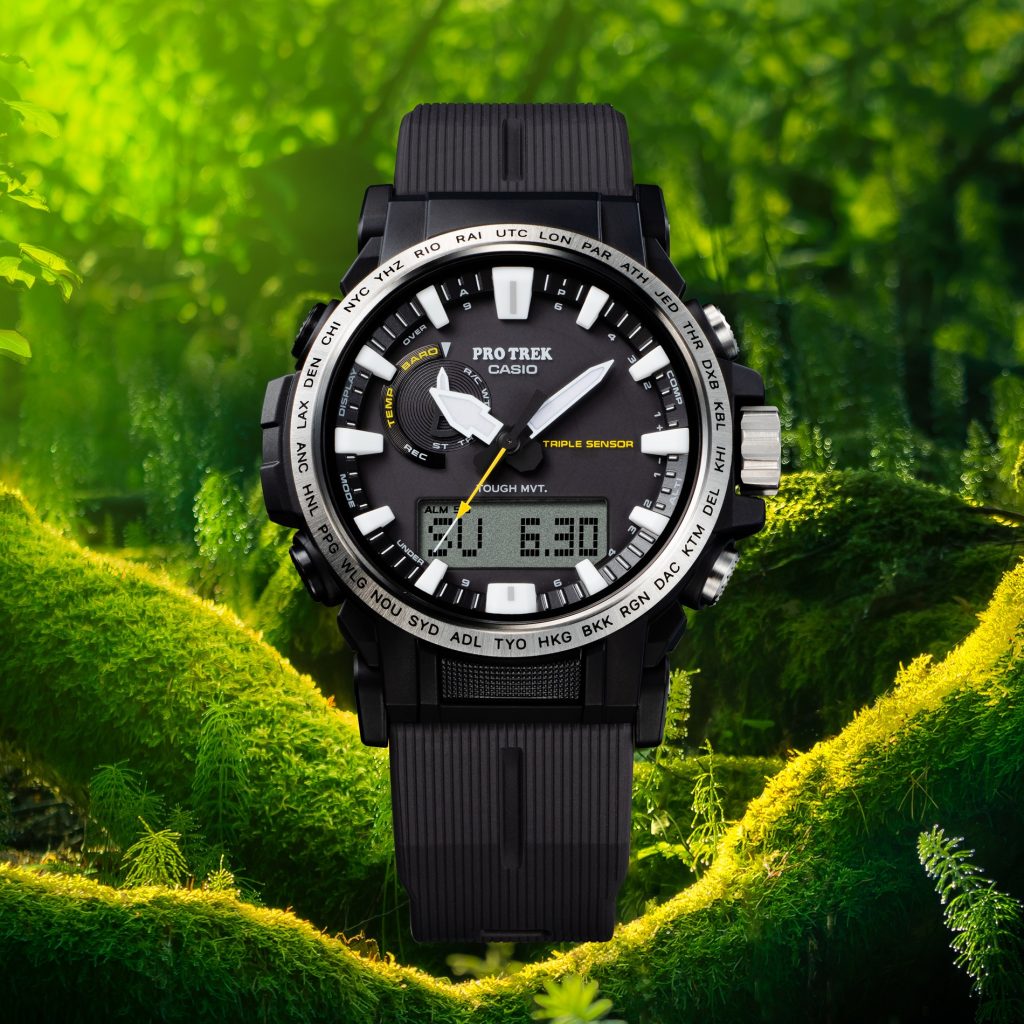For one reason or another, we tend not to think about the impact of what it takes to manufacture these watches that we admire and collect. For a mechanical movement in a steel case, the argument that they’ll last forever (and can be recycled once they break) makes some sense. But what about those quartz-driven watches that live in plastic cases? Those can be done better as well, which the Casio ProTrek PRW61 demonstrates.
How does it do that? Well, the Casio ProTrek PRW61 is the first ProTrek to feature a case made of a bioplastic. What this means is that rather than being fully petroleum-based, it’s relying on castor seeds and corn (among other materials), reducing the resource impact. Oh, and it’s not just the case – the caseback and strap are also made of the material. How’s the longevity of the material? Well, that’s something that only time will tell.

Once you get past the new eco-friendly material, the Casio ProTrek PRW61 is a ProTrek that we’re all quite familiar with. Along with the full complement of quartz watch features (alarms, timers, world time) and outdoors-oriented capability (temperature, barometer, altimeter, and compass), you’ve got that oh-so-lovely Tough Solar built in. Meaning, this watch draws its power from the sun, rather than a disposable coin cell. How long will that capacitor work? Quite a while, if my 14 year-old solar G-Shock is any indication.
Also like that old G-Shock of mine, the Casio ProTrek PRW61 can sync its time to the atomic clock radio signals being broadcast around the world. This means the watch will always have the right date and time. The combination of atomic sync and solar power is one I’ve always liked, and I think makes for a very solid outdoors-oriented watch.

I also like how the Casio ProTrek PRW61 has really made it easier to read (and use) than my older G-Shock. The 51mm case has a large dial, with generously sized indices and hands. Also, rather than having to rely solely on small subdials to figure out what you’re doing with the watch, there’s a small digital display, which is going to be a big help to any owners of the watch.
The Casio ProTrek PRW61 was released last month, and is available right now for $420. If you’re looking for an outdoors watch that can keep up with whatever you’re doing, this is definitely a solid option. Perhaps not as robust of protection as a G-Shock, but you get a lot of outdoors-oriented functionality in a ProTrek that is hard to argue with. protrek.casio.com

Tech Specs from Casio
- Case / bezel material: Resin / Biomass Plastic
- Resin / Biomass Plastic Band
- Mineral Glass
- 100-meter water resistance
- Tough Solar (Solar powered)
- Full auto double LED light, selectable illumination duration (1.5 seconds or 3 seconds), afterglow
- Time calibration signal reception
- Auto receive up to six* times a day (remaining auto receives canceled as soon as one is successful)
- *5 times a day for the Chinese calibration signal
- Manual receive: the latest signal reception results
- Time Calibration Signals
- Station name: DCF77 (Mainflingen, Germany)
- Frequency: 77.5 kHz
- Station name: MSF (Anthorn, England)
- Frequency: 60.0 kHz
- Station name: WWVB (Fort Collins, United States)
- Frequency: 60.0 kHz
- Station name: JJY (Fukushima, Fukuoka/Saga, Japan)
- Frequency: 40.0 kHz (Fukushima) / 60.0 kHz (Fukuoka/Saga)
- Station name: BPC (Shangqiu City, Henan Province, China)
- Frequency: 68.5 kHz
- Auto receive up to six* times a day (remaining auto receives canceled as soon as one is successful)
- Low-temperature resistant (-10 °C/14 °F)
- Digital compass
- Measures and displays direction as one of 16 points
- Measuring range: 0° to 359°
- Measuring unit: 1°
- 20 seconds continuous measurement
- Graphic direction pointer
- Bidirectional calibration and northerly calibration function
- Magnetic declination correction
- Bearing memory
- Altimeter
- Measuring range: -700 to 10,000 m (-2,300 to 32,800 ft.)
- Measuring unit: 1 m (5 ft.)
- Manual memory measurements
- (up to 30 records, each including altitude, date, time)
- High Altitude / Low Altitude memory
- Total Ascent / Descent memory
- Others: Reference altitude setting, Altitude tendency graph, Altitude differential
- *Changeover between meters (m) and feet (ft)
- Barometer
- Display range: 260 to 1,100 hPa (7.65 to 32.45 inHg)
- Display unit: 1 hPa (0.05 inHg)
- Atmospheric pressure tendency graph
- Atmospheric pressure differential graphic
- *Changeover between hPa and inHg
- Thermometer
- Display range: -10 to 60 °C (14 to 140 °F)
- Display unit: 0.1 °C (0.2 °F)
- *Changeover between Celsius (°C) and Fahrenheit (°F)
- World time: 29 time zones (29 cities), city code display, daylight saving on/off
- 1/100-second stopwatch
- Measuring capacity: 23:59’59.99
- Measuring modes: Elapsed time, split time, 1st-2nd place times
- Countdown timer
- Measuring unit: 1 second
- Countdown start time setting range: 60 minutes
- Countdown start time setting range: 1 minute to 60 minutes (1- minute increments and 1-hour increments)
- Daily alarms: 5 independent daily alarms
- Hourly time signal
- Battery level indicator
- Power Saving (Display goes blank to save power when the watch is left in the dark.)
- Full auto-calendar (to year 2099)
- 12/24-hour format
- Button operation tone on/off
- Regular timekeeping:Hour, minute, second, pm, year, month, date, day
- Accuracy: ±15 seconds per month
- Approx. battery operating time:
- 6 months on rechargeable battery (operation period with normal use without exposure to light after charge)
- 25 months on rechargeable battery (operation period when stored in total darkness with the power save function on after full charge)
- Size of case : 51.0×47.1×14.7mm
- Total weight : 53g











